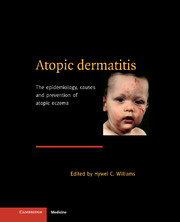Book contents
- Frontmatter
- Contents
- List of contributors
- Foreword Georg Rajka
- Preface
- Part I The nature of the problem
- Part II Descriptive studies which indicate the size of the problem
- Part III Analytical studies which point to causes of atopic dermatitis
- 8 Genetic epidemiology of atopic dermatitis
- 9 Fetal and perinatal origins of atopic dermatitis
- 10 Social factors and atopic dermatitis
- 11 The ‘old mother’ hypothesis
- 12 The possible role of environmental pollution in the development of atopic dermatitis
- 13 Atopic dermatitis in migrant populations
- 14 The role of inhalant allergens in atopic dermatitis
- 15 Dietary factors in established atopic dermatitis
- Part IV Intervention studies
- Part V Lessons from other fields of research
- Part VI Conclusions
- Additional information
- Index
- Plate section
14 - The role of inhalant allergens in atopic dermatitis
from Part III - Analytical studies which point to causes of atopic dermatitis
Published online by Cambridge University Press: 17 August 2009
- Frontmatter
- Contents
- List of contributors
- Foreword Georg Rajka
- Preface
- Part I The nature of the problem
- Part II Descriptive studies which indicate the size of the problem
- Part III Analytical studies which point to causes of atopic dermatitis
- 8 Genetic epidemiology of atopic dermatitis
- 9 Fetal and perinatal origins of atopic dermatitis
- 10 Social factors and atopic dermatitis
- 11 The ‘old mother’ hypothesis
- 12 The possible role of environmental pollution in the development of atopic dermatitis
- 13 Atopic dermatitis in migrant populations
- 14 The role of inhalant allergens in atopic dermatitis
- 15 Dietary factors in established atopic dermatitis
- Part IV Intervention studies
- Part V Lessons from other fields of research
- Part VI Conclusions
- Additional information
- Index
- Plate section
Summary
Introduction
It was only after considerable resistance that the name for this form of eczema was changed from ‘Besnier's prurigo’ – a title reflective of merely the predominant symptom – to ‘atopic dermatitis’ (AD) which more aptly describes the underlying nature of the disease. Acceptance of this new name in the 1930s reflected not only the growing awareness of an association between the disease and other manifestations of atopy but also the view that exposure to allergens played a significant role in the disease (Atherton, 1981; Sulzberger & Vaughan, 1934; Rost, 1932). In the last century, Vidal reported the association between asthma and a type of dermatitis (Vidal, 1886), and in 1923 Coca suggested a familial role for the development of asthma, eczema and allergic rhinitis (Coca & Cooke, 1923). In 1949, Tuft reported that most adult patients with AD had positive skin tests to autologous house dust (Tuft, 1949). He went on to demonstrate both exacerbation of eczema with inhaled dust, as well as improvement of skin symptoms when houses were ‘cleaned’.
Despite the mounting evidence that allergens played a role in the disease, considerable scepticism remained, largely based on (but not limited to) the observation that immunotherapy with suspected allergens failed to elicit improvement in patients' symptoms. This finding could have been attributed to lack of specificity of the allergens used (for example, house dust was simply a ‘black liquid’ since dust mites were yet to be discovered).
- Type
- Chapter
- Information
- Atopic DermatitisThe Epidemiology, Causes and Prevention of Atopic Eczema, pp. 183 - 192Publisher: Cambridge University PressPrint publication year: 2000



